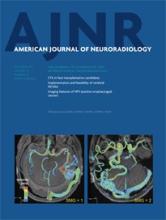We read with great interest the recent article entitled “Diffusion-Weighted MRI: Distinction of Skull Base Chordoma from Chondrosarcoma” by Yeom et al.1 The authors showed, with a sample of 19 patients, that skull base chondrosarcomas could be differentiated from chordomas and from atypical chordomas by ADC values on diffusion-weighted MR imaging. This result represents a significant advance, because there are no other imaging approaches to reliably distinguish these central skull base tumors. We have now replicated these findings with a sample of 14 chordoma and 10 chondrosarcoma cases from our own institution. Similar to Yeom et al, we found that chondrosarcomas demonstrate substantially larger average ADC values compared with chordomas and that this difference is highly significant (chondrosarcoma median ADC: 214 × 10−5 mm2/s; 25th percentile: 176 × 10−5 mm2/s; 75th percentile: 229 × 10−5 mm2/s; chordoma median ADC: 135 × 10−5 mm2/s; 25th percentile: 116 × 10−5 mm2/s; 75th percentile: 144 × 10−5 mm2/s; P < .001, Mann-Whitney U test). Chordomas have a significantly worse prognosis than chondrosarcomas, with 5-year progression-free survival estimated at 80% for chondrosarcomas but only 40% for chordomas.2 Thus, distinguishing these 2 entities has important implications for treatment planning and patient counseling. Further investigation of diffusion-weighted MR imaging of skull base tumors should be pursued, because it is likely to identify additional diagnostic and prognostic features that will impact clinical and surgical management of these lesions.
REFERENCES
- © 2013 by American Journal of Neuroradiology












